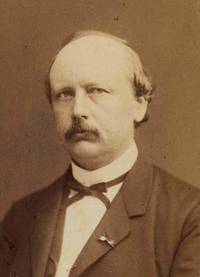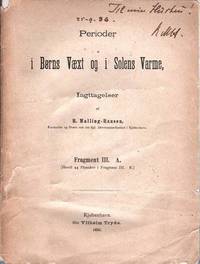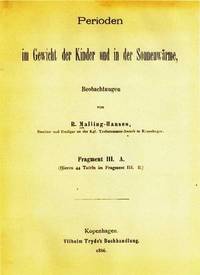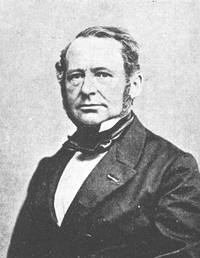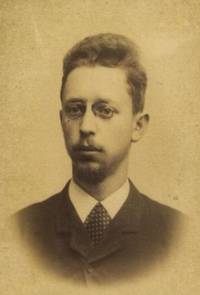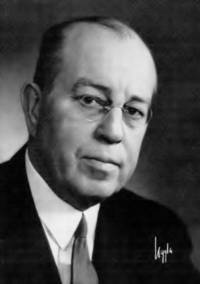Malling-Hansen’s Research into Seasonal Variations in the Growth of Children - an Overview and an Update, April 2017.
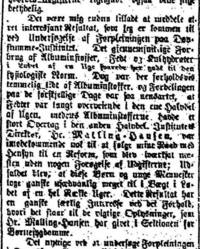
- Ludwig Panum's lecture at the large doctors conference in Copenhagen, 1884 was referred in its whole in Danish newspapers. This is the part of the lecture where Panum tells about his initiative to renew the dining rules at the institute. This change was followed up by RMH's systematic weighings and measurings of the children.
Research and comments by Jørgen Malling Christensen.
Illustrations by Sverre Avnskog.
Research for a good purpose.
When Rasmus Malling-Hansen initiated his weighings and measurements of a small group of pupils – only 23 - in 1877, his motivation was shaped by practical purposes and by his strong sense of care for the children of the institute: His aim was to find the best possible diet in terms of ensuring their good health. This was in tandem with other, similar, changes he had instituted since he was appointed principal in 1865; for example he increased the time available for outdoor play; made sure that all pupils would work in the orchard of the institute, helping to grow their own vegetables, herbs and fruit, in the process getting fresh air, exercise and sunshine; and he improved the indoor climate also, by means of better ventilation.
Nutrients and metabolism were not yet well understood
Malling-Hansen’s pioneering research should be understood against the background of the very limited understanding of nutrition and nutrient elements in the world in 1877: We must keep in mind that science was only on the verge of discovering and understanding nutrients such as vitamins[1], proteins and minerals. The understanding of fats, carbohydrates and other macro and micro nutrients was non-existent among the population at large and very limited even among the most advanced scientists.
Hence, Malling-Hansen could not find guidelines or answers in the scientific literature, nor could he obtain any authoritative or well-grounded information in the circles of scientific experts of the time. On the question of the best possible diet, he did receive advice from Professor Peter Panum[2], and it appears to have been Panum who initially suggested Malling-Hansen to conduct his own studies. But it was also in Malling-Hansen’s nature to be inquisitive and thorough, and he had a strong self-confidence. So, undaunted by the immensity of the task, he set out to experiment with various combinations of what he called the “regimen” (the institutional diet).
Unexpected results
His expectation was that the experiments conducted 1877-78 would show what kind of food combination would lead to steady, uninterrupted and healthy weight gain (growth) in the children and to a general improvement of their health. He did not expect that which he found: that irrespective of their food supply and their degree of physical activities, the growth of the children was not regular or linear over time, rather it was startlingly seasonal and jumpy! The belief and the assumption at the time – shared by common people as well as by scientists – was that children and young people (under normal conditions of good health and good food) would grow at a regular pace, evenly maintained throughout the year, and Malling-Hansen was the first to find a seasonal pattern.
Malling-Hansen mentions in Fragment I (1883) that he originally planned to conduct his experiments for only one year. However, the unexpected results of his weighings and measurements, using rigorous scientific methods and analyses, were so surprising that they spurred him on. We know from the surviving notebooks, recording the data of the measurements and weighings, that he continued this line of research on and off up until his premature death in September 1890. It is very likely that he planned to publish a “Fragment 4”, but he died before he could accomplish this task.
Reasons for the continuation of the research
The reasons for continuing the experiment after the initial findings in 1877-78, increasing the scale to eventually include most of the 130 pupils of the institute, were probably a combination of the following factors:
1) He became frustrated and intrigued by the initial findings that there seemed to be no clear causality between the quality and quantity of the diet on the one hand[3] and the weight gain/bodily growth on the other hand. Rather, weight gain and growth was seasonal and occurred in jumps – in periods he found it to be negative or at a complete stand-still – and he could not fathom the reasons why.
2) Malling-Hansen’s scientific curiosity was aroused; what started as an experiment with a decidedly practical purpose gradually developed into something else. The practical purpose – to find the best diet – was never abandoned, but to this was added his search for “Factor X” – the elusive cause behind the seasonal pattern of growth. Alas, he died before he found Factor X. As we shall see later on, scientists all over the world have, since then, continued the search for the Factor X!
Four important factors helped him along
Malling-Hansen’s research project was greatly supported by at least four circumstances:
a) He enjoyed the trust of his immediate superior in the Ministry of Education, Director J.P. Trap[4], who interfered very little in the daily affairs of the institute and delegated most of the responsibility and decisions to his trusted principal. When Wolfhagen[5] took over the directorship in late 1884, Malling-Hansen’s position and possibilities deteriorated. If Wolfhagen had been his superior officer in the 1870s and first half of the 1880s, I assume that he would not have permitted Malling-Hansen to use that much time and resources to the research activities; however, Wolfhagen probably felt (in 1884 and following years) that he could not forbid Malling-Hansen to continue his research, since he had obtained public financial support on several occasions, and since Malling-Hansen had successfully presented his findings at the International Medical Congress in Copenhagen in 1884.
b) Malling-Hansen was privileged in the sense that he received funding from the Carlsberg Foundation and from the Danish government for his scientific research. Thus in 1882 he received 4000 kroner and in 1885 another portion of 4000 kroner from the Carlsberg Foundation. In his November 1885 application for funding he mentioned that he had received 6000 kroner from the Danish government. This funding enabled him to acquire the proper equipment, have urine samples from the pupils regularly analysed and to publish his results – Fragment I in 1883, Fragment II in 1884 and Fragment III a and b in 1886.
c) Malling-Hansen was fortunate that the International Medical Congress was held in Copenhagen and at a point in time (August 1884) when he had had time to gather sufficient evidence to be able to be allowed to present his findings to this audience and to the world. He made very good use of this excellent opportunity, and his presentation was received with much attention and respect by the international medical elite. This was followed up and further stimulated by numerous articles in foreign newspapers and journals (see the articles published on our site).
d) As the principal of a boarding institution with around 130 pupils, Malling-Hansen was in the rather special (and privileged) situation of being able to weigh and measure all pupils daily over a long period of time. In order to replicate his study – or to disprove his results – other scientists would have had to find similar stable research objects, which could be followed and monitored daily in one single institution and over a long period of time. Rather few scientists would have that favourable situation.
School hygiene
During this period - the 1870s and 1880s - there was a worldwide general and strong interest in the issue of what was called “school hygiene” – a broad concept used by medical science, by educationalists and by politicians of that period to cover everything connected with the health and welfare of school children. Hence, Malling-Hansen was by no means alone in this point of focus, and this general interest in “school hygiene” and in Public Health issues certainly stimulated the interest in Malling-Hansen’s research.
There were also a small number of other scientists and heads of schools and institutions who carried out similar studies – in Denmark. Malling-Hansen mentions (in Fragment I) two such studies in Denmark:
1) Over a period of 9 years, the principal of a foundation for girls and young women (Jægerspris), Dr Martin Wahl (1827-1887)weighed all boarders individually twice per year;
2)Otto Nicolai Jensen (1840-1915), principal of a similar institution for boys (“Det Kongelige Opfostringshus”) weighed all boys once a month over a period of 18 months.
The uniqueness of Malling-Hansen’s research
However, compared to these two cases, Malling-Hansen’s method was much more detailed, thorough and rigorous, as from 1882 weighing all 130 pupils daily and measuring their height over a period stretching until the beginning of 1886.
The other important difference is that Malling-Hansen also measured biological growth – the seasonal growth of trees – in an attempt to find natural laws for all biological growth. It is clear from his Carlsberg Foundation funding application of January 4, 1883, that he was trying to find out whether the moon or the other planets of our solar system could have something to do with the unknown Factor X.
What also makes Malling-Hansen’s approach unique is that he made use of international meteorological data from stations all over the world. He was trying to ascertain if there was, indeed, a global phenomenon that determined the rate of growth of the human body (and ultimately of all biological growth[6]).
While Malling-Hansen started his physiological research as a local, institution-based project, over time he expanded it to have a global scope! He probably reasoned that if there was a universal growth factor X, the effects of which he had found and proven on his own pupils, then this universal factor – emanating from celestial bodies and unknown forces – would obviously also have similar effects on all other children on earth and on all living species.
The idea was exceedingly bold, but it was not crazy! After all, the natural phenomena and laws which science has discovered in the course of the last three centuries have an impact on all life on earth. And obviously some of these natural phenomena have their origin and causes in universal forces in the immediate surroundings of planet Earth. Obvious examples are: Gravity; effects from the moon on ebb and tide; solar heat, flares and storms; effects from other planets in our solar system; forces connected with our place in the Milky Way and forces from the galaxy (some of which may not yet be known).
Malling-Hansen’s ideas were not farfetched! And their foundation consisted of his rigorous research producing reliable data and using strictly empirical, objective methods. Though he had never had any scientific training, Malling-Hansen learned by doing and by using his own intellect and power of reasoning[7]. He probably also received good advice about research methods from Peter Panum and from the giant of Danish science at the time, Japetus Steenstrup[8]. Malling-Hansen had personal contacts with Steenstrup, who was an uncle of Malling-Hansen’s second wife, Anna Steenstrup.
Malling-Hansen’s Research Project Stopped with his Demise
After the publication of “Fragment III a and b” in 1886, Malling-Hansen continued his weighings and measurements, albeit at a smaller scale, filling out countless notebooks with the results and proceeding to analyse the results. His main aim was, of course, to identify the elusive Factor X, which he believed was behind the mysterious seasonal pattern of bodily weight gain and growth of children (and of all living things).
However, the last four-five years of his life were dogged by ill health and by his many stressful official duties and problems. Malling-Hansen suffered from a heart condition which eventually caused his stroke in September 1890. The progress of his scientific work was also hampered by his many duties, not only as a very busy principal but also as secretary of the ministerial commission that planned for the future organisation of education for the deaf-mute, the blind and the mentally handicapped[9]. He also had a key role in the planning of the new institute for the deaf-mute at Nyborg, inaugurated in 1891, after his death.
Much time and energy was also taken up by his conflict in 1884 and 1885 with his superior, Friedrich Hermann Wolfhagen, who had assumed office in the autumn of 1884. Likewise, he suffered a disappointing setback when much of his planning for extending and improving his institute was brutally and in humiliating manner axed by the royal building inspector, the influential architect Ferdinand Meldahl[10] in September 1883.
Since Malling-Hansen was – even in his last five years – a brilliant writer as well as public speaker, he was constantly sought after for giving speeches and formulating reports and plans. His oratory talents made him speaker of the freemason lodge during his last two years, and surely this responsibility – however important and dear it was to him – also taxed his energy and health.
The period from approximately 1887 to 1890 was also the period when Malling-Hansen dedicated time and energy to learning the new artificial language Volapük and to help developing its use in Denmark. He learned it well enough to be able to translate from Danish into Volapük and vice versa; he started Volapük clubs and he gave lectures about the benefits of this international language[11].
As mentioned above Malling-Hansen continued, also after the publication of “Fragment III a and b” in 1886, to collect and analyse data about the seasonality of weight and height development of children. However, his short remaining lifespan and his frail health did not allow him to publish any follow-up work, and we have, as of now, no indication that he got any further in his search for Faxtor X than what has been documented in Fragment III a and b.
However, as we shall see in the following, other scientists have since his time continued his line of research. This line of research remains active to this day.
Strandgaard[12]: Seasonal Pattern of Weight Fluctuations in Tuberculosis[13] Patients.
Niels Julius Strandgaard was a Danish physician who dedicated his life to the treatment and research on tuberculosis. He published an article in the Danish Journal “Hospitalstidende” on April 1, 1914. We have not yet found the original article, however it was important enough to be mentioned and quoted in the medical journal “The Lancet” of June 13, 1914, and the Lancet article is on our website.
For our present purposes, the interesting aspect is that Strandgaard investigated weight gain (and loss) of his TB patients and found a marked seasonal pattern of weight gain. He surmised that the weight gain was correlated to the relative humidity of the atmosphere and to the air temperature. He reported that his results of 10 years of research were strikingly similar to the seasonal pattern obtained by Rasmus Malling-Hansen. The Lancet article also mentions other contemporary physicians and researchers obtaining similar results, namely H. Adsersen[14]; and Bondeson and Jörgenson. To these scientists working in the tradition of Malling-Hansen around the turn of the century should be added Dr Hans Jakob Hansen, 1865-1930 (see footnote below).
Gustav Nylin and his doctoral thesis
Karl Gustav Vilhelm Nylin, 1892-1961, was a Swedish physician and cardiologist of international recognition. He was a great admirer of Malling-Hansen’s research, and as a young school physician in a Stockholm suburb he replicated Malling-Hansen’s research in 10 schools under his responsibility. From 1926 until 1929 he regularly weighed and measured 2416 pupils, of which 1903 were included in the complete series of measurements. Hence, Dr Nylin obtained a vast statistical material and this became his doctoral thesis: “Periodical Variations in Growth, Standard Metabolism and Oxygen Capacity of the Blood of Children”, successfully defended in January 1930 at the Karolinska Institute, Stockholm.
Dr. Nylin used the same techniques and methods as Malling-Hansen, and, in addition, he broadened the perspective by including measurements of the standard metabolism and oxygen capacity of the pupils. This was a logical and clearly relevant extension of the Malling-Hansen research agenda.
Dr. Nylin found the very same seasonal pattern as that of Malling-Hansen in terms of weight and height. Moreover, he also found that during the maximum periods of growth in height, the basic metabolism was also at a maximum level.
Dr. Nylin also added the aspect of light radiation and its effects; he found a correlation between the amount of light and growth in terms of height.
The latter aspect leads us to another important scientist, namely the Danish-Faroese physician and physiologist Niels Ryberg Finsen (1860-1904), the first Dane to win a Nobel Prize (1903). In his doctoral thesis, Nylin points out that Finsen was inspired by Malling-Hansen and that he referred to RMH’s research in some of his reports. Finsen was primarily interested in the biological effects of light and experimented with phototherapy (light radiation) as a cure for various cutaneous conditions, primarily lupus vulgaris. Finsen is regarded as one of the founders of radiotherapy, also known as radiation therapy or RT/RTx/XRT (other founders being Marie Sklodowska Curie,1867-1934, and Wilhelm Röntgen, 1845-1923).
In his research Finsen demonstrated the seasonal variations of haemoglobin in human blood. He found that haemoglobin[15] levels increase, on average, by 15% in summertime, compared to winter period levels. Finsen concluded his investigation with these words[16]:
“The study of physiological periodicity is closely connected with the study of the Sun and with the biological effects of sunlight, as surely as the Sun causes the fluctuations of day and night, summer and winter.”
In 1930 Gustav Nylin visited Copenhagen and gave a lecture about Malling-Hansen’s and his own research (see on our website: “Lecture by Gustav Nylin in 1930”). In his lecture, Nylin praised Malling-Hansen for being “...the first researcher to define and practise a precise, scientifically accurate research methodology”. Moreover, he stated that Malling-Hansen was: “...the first to have analyses, with care and accuracy, the variations in height and length of school-children, and to have found that their height decreases every day by 10 mm”. He added that, apart from the French scientist Leclerc de Buffon(1707-1788) and the Swedish physician Erik Vilhelm Wretlind (1838-1905), “...Malling-Hansen was the first to have found and documented a seasonal variation in terms of the growth of height and weight”.
The first chapter of Nylin’s thesis is on our website (“A Swedish Scientist in Malling-Hansen’s Footsteps”). This chapter is a marvellous source of information, because here Nylin records the names of other important scientists who followed in Malling-Hansen’s footsteps, continuing this particular field of research. He lists the names and nationalities of 56 scientists:
Denmark: Martin Vahl, Niels Julius Strandgaard, Jens Peter Johannes Lindhard, Wilhelm Ludvig Johannsen, Niels Ryberg Finsen, Hjalmar Heerup.
Norway: Klaus Hansen, Carl Schiøtz, Alette Schreiner, E. Grundt, Hjalmar Høegh Kielland, N. Lunde, J.F. Bratt, O. Scheel, Thomas Føien.
Sweden: Erik Vilhelm Wretlind, Axel Key, Klas Gustaf Anders Sonden, Karl Gustav Vilhelm Nylin.
Finland: Rancken, Rita Gripenberg, J. Grönberg, Robert Adolph Armand Tigerstedt, Hanna Olin.
England: James Kerr, A. Bleyer, Edward Smith, Frederick Griffith.
USA: W. T. Porter, Borden S. Veeder, E. H. Rohlfing, Haven Emerson, N. B. Burns, Francis Gano Benedict, Fritz B. Talbot, Eugene Floyd Du Bois, William John McConnell, Fulton, Yagloglou, Margarete Kunde, Florence L. Gustafsson.
France: Carlier, Louis Denis Jules Gavarrett.
Germany: Ludolf von Krehl, Johann Friedrich Wilhelm Camerer, Karl Schmid-Monnard, Hildegard Frank, Wimberger,A. Hartmann, Otto Kestner, Friedrich Peemöller, H. Gessler, Adolg Loewy, W. A. Jakowenko.
Austria: Herbert Orel.
Australia: Young.
Everett L. Marshalls[17] updated List of Researchers
In the June 1937 issue of “The Journal of Pediatrics” the American psychologist Everett L. Marshall published an article, in which he reviewed and summarised 23 studies by American scientists, all of them replicating Rasmus Malling-Hansen’s pioneering research – or, at least, carrying out research along the same line, seeking to verify or not verify a seasonal pattern of growth. For details, we refer to the article which is on our website.
Some of these researchers found a seasonal pattern akin to that found by Malling-Hansen, others did not; however, the point to underline here is that Dr. Marshall has done us a great favour by reviewing and summarising the research in this field, because his article provides us with names, titles and the year of publication of those who followed in Malling-Hansen’s footsteps and, hence, is a valuable addition to the list of researchers provided by Dr. Nylin in his 1929 thesis.
The researchers listed (and not previously mentioned by Dr Nylin) are:
Richard E. Scammon, 1927
Barker Sanders, 1934
F. W. Hitchings and G. W. Fitz, 1901
Harold K. Faber, 1920
Joseph Berkson, 1930
Ruth Sawtell Wallis, 1931
Hughine McKay and Mary Ann Brown
L. E. Holt, 1918
Emmet Holt and Helen L. Fales, 1923
John C. Gebhardt, 1924
W. T. Porter and P. C. Baird, 1927
Harry N. Gould 1930
Margaret Chaney and Margaret Justin, 1928-30
Carrol E. Palmer, 1933
C. B. Davenport, M. Steggarda and W. Drager, 1934
Jessie Whitacre, 1935.
Further details, such as titles of their research reports, are found in the Marshall article.
Carroll Edwards Palmer Replicating Malling-Hansen’s Research in 1933
C. E. Palmer[18], 1903-1972, was a towering figure in public health, particularly in regard to research on the diagnosis, treatment and prevention of tuberculosis. He initially served as a consultant at the US Public Health Service and as from 1942 as the director of the Tuberculosis Research Program. In 1949 Palmer was appointed director of the World Health Organisation Tuberculosis Research Office of the United Nations.
Between 1923 and 1928 Palmer carried out monthly weighings of 2,500 schoolchildren of the ages 6 to 16. His aim was to investigate whether there was a seasonal pattern of growth. Palmer did indeed find a seasonal pattern similar to the one found and documented by Malling-Hansen[19].
However, our purpose in the context of this article is not to go into details about Dr Palmer’s results. Our interest lies in the fact that he did, in fact, continue Malling-Hansen’s line of research; and our second focus is on Palmer’s references at the end of his article, because they add to our list of scientists who have followed in Malling-Hansen’s footsteps, continuing this particular line of research.
Palmer’s references are:
R. Martin, 1924 (Germany)
A. A. Mumford, 1912-14 (UK)
Ada G. Paterson and E. Marshall, 1927 (New Zealand)
C. M. Jackson, 1931 (USA)
G. Wolff, 1932 (Germany)
F. Boas, 1898 (Canada)
S. Schiøtz, 1923 (Norway)
F. Gray, 1910 (USA)
Louis Schwartz, R. H. Britten and L. R. Thompson, 1928 (USA)
C. B. Davenport and Blanche M. Minogue, 1930 (USA)
T. W. Todd, 1930 (USA)
C. B. Davenport, 1926 (USA)
L. K. Frankel and L. L. Dublin, 1916 (USA)
W. T. Porter, 1893 (USA)
F. Boas and C. Wissler, 1906 (USA)
H. G. Richey, 1931 (USA)
F. Boas, 1932 (USA)
S. D. Collins, 1931 (USA).
The titles of the above research reports are found in our article about Dr Palmer’s research results.
A Contemporary Danish Study of Seasonal Variations in Growth and Body Composition
“Pediatric Research”, volume 79, no. 2, issue of February 2016 has a very important and interesting article: “Seasonal variations in growth and body composition of 8-11-y-old Danish children”. The article presents a succinct summary of a fascinating piece of research, continuing and developing the line of research initiated by Rasmus Malling-Hansen in the 1870s and 1880s!
The full text of the abstract is now free to use! It can be found on www.nature.com/pr/journal/v79/n2/index.html It is rather technical, but I recommend it highly for its clarity, brevity and relevance in relation to the RMH research. It is clearly a landmark!
The research team[20] behind the study is from the Department of Nutrition, Exercise and Sports, Faculty of Science, University of Copenhagen.
Some 140 years ago, when Rasmus Malling-Hansen initiated his research into children’s gains in height and weight, he did so – as pointed out in the opening parts of this article – with the aim of finding the best possible nutrition for the school-children under his care. There is an interesting parallel here, when comparing with the objectives and the contextual conditions of the Danish research team; because their particular piece of research – “The OPUS School Meal Study” – is an important element in the overall context of the “New Nordic Diet” and the OPUS project.
The purpose of the OPUS school meal intervention is to investigate the effect of the “New Nordic Diet”[21] on the well-being, development and state of health of schoolchildren. More details are found on www.foodoflife.ku.dk/opus Under OPUS, 300 healthy recipes have been developed, and the meals are tailored to the food patterns of children aged 8 to 10.
The article in “Pediatric Research” is a very short summary of the results of the research carried out between August 2011 and June 2012. 760 children from nine schools between the ages of 8 and 11 were included. Measurements were taken every three months of weight, height, body mass index (BMI),fat mass index (FMI) and fat-free mass index (FFMI)and the team searched for possible seasonality.
The findings suggested (but did not prove indisputably) seasonality in growth and body composition. However, the findings for height were in agreement with results from previous studies – among them Rasmus Malling-Hansen’s study published in 1886 and which is mentioned as the first of the scientific references!
From the point of view of the International Rasmus Malling-Hansen Society, of primary interest in this context are these three aspects:
1) Rasmus Malling-Hansen’s groundbreaking research, undertaken from 1877 and well into the 1880s, continues to be relevant and remains a scientifically recognised point of departure even for contemporary research in this area;
2) This particular line of research – seasonality of growth of the human body - has been ongoing ever since Malling-Hansen’s time and is still ongoing! It has been and is undertaken in several parts of the world; this field of research is alive! And the reasons behind seasonality have not yet been found!
Malling-Hansen was searching for what he called “Factor X”. Factor X has still not been found, but its effects continue to show up!
3) The OPUS research team has done us the great service of providing a summary of previous research on the first page of their article; furthermore, their list of references provides further clues and is very helpful in terms of identifying relevant scientists and their research papers. For full details we refer to the last page of the article. However, it is meaningful here to list the most relevant of these names, together with their year of publication, since this list is a natural update to the previous lists of researchers, mentioned above.
Their references are:
1. R. Malling-Hansen, 1886
2. E. R. Bransby, 1945
3. W. A. Marshall, 1971
4. J. B. Orr and M. L. Clark, 1930
5. E. L. Reynolds and L. W. Sontag, 1944
6. E. Takahashi, 1966
7. H. Emerson, 1927
8. T. W. Porter, 1920
9. S. Kondo, E. Takahashi, K. Kato, S. Takahashi, M. Ikeda, 1978
10. M. Ikeda and T. Watanabe, 1985
11. L. Gelander, J. Karlberg, K. Albertsson-Wikland, 1994
12. V. Tillmann, N. K. Thalange, P. J. Foster, M. S. Gill, D. A. Price, P. E. Clayton, 1998
13. L. Gelander, W. F. Blum, L. Larsson, S.Rosberg, K. Albertsson-Wikland, 1999
14. C. Land, W. F. Blum, A. Stabrey, E. Schoenau, 2005
15. D. I. Shulman, J. Frane, B. Lippe, 2013
16. T. Baranowski, T. O’Connor, C. Johnston, et al, 2014
17. A. X. Rodriguez, N. Olvera, P. Leung, D. P. O’Connor, D. W. Smith, 2014
18. R. Luboshitzky, D. Yanai, Z. Shen-Orr, E. Israeli, P. Herer, P .Lavie, 1998
19. R. Valcavi, M. Zini, G. J. Maestroni, A. Conti, L. Portioli, 1993
20. S. Cahill, E. Tuplin, M. R. Holahan, 2013
21. L. Marco-Gracia, F. B. Ortega, J. R. Ruiz, et al, 2013
22. M. F. Hjort, J. P. Chaput, K. Michaelsen, A. Astrup, I. Tetens, A. Sjödin, 2013
23. C. T. Damsgaard, S. M. Dalskov, R. A.Petersen, et al, 2012
24. C. T. Damsgaard, S. M. Dalskov, R. P. Laursen, et al, 2014.
From the point of view of the International Rasmus Malling-Hansen Society our task is to continue to keep abreast of contemporary research in this field, as well as to document previous relevant research projects in so far as they are relevant to Malling-Hansen and his research contributions.
[1] JMC: The various vitamins were isolated and understood during the period from 1926 to 1939.
[2] JMC: Peter Ludwig Panum, 1820-1885, world famous Danish pathologist and physiologist, known for his important work to contain the cholera epidemic at Bandholm, Lolland, in 1853. Also known for his research and work in connection with the measles epidemic at the Faroe Islands in 1846. Panum was professor of physiology in Kiel fra 1855 and from 1862 professor at the University of Copenhagen. Panum is acknowledged as being the first person to perform systematic and scientific studies of endotoxin (the term is today used synonymously with that of lipopolysaccharide). Panum served as president of the International Medical Congress in Copenhagen in August 1884, at which Rasmus Malling-Hansen presented his ground-breaking physiological research.
[3] JMC: He introduced a diet with more meat and milk, and initially this led to weight gain; however, after a few weeks, the weight gain vanished, and the previously found seasonal pattern of weight gain/loss prevailed once again.
[4] JMC: Jens Peter Trap, born 19 Sept 1810, died 21 January 1885. Trap held the important position of Secretary of State, working very closely with four successive kings and their families. He was also the author and publisher of a calendar as well as the most important topographical work of the 19th century in Denmark. In addition, Trap was a high-ranking freemason, in 1870-71 holding the position of grand-master. From 1842 and until his death Trap produced a yearly edition of the state calendar. He was also the author of the monumental “Statistical and Topographical Description of the Kingdom of Denmark” (in Danish only), first edition 1856-60 and subsequently in several editions. Trap’s autobiography is a fascinating account of his work and association with four Danish kings ( Frederik 6. 1808-1839; Christian 8. 1839-1848; Frederik 7. 1848-1863; Christian 9. 1863-1906) and their family members. Due to its personal and intimate nature, it was published as late as in 1966 – 81 years after his death! – and entitled: “Fra fire kongers tid” (3 volumes, only in Danish). In addition to all these important responsibilities Trap was also director of the Royal Institutes for the Deaf-Mute and for the Blind from 1865. As such, he was the superior of Rasmus Malling-Hansen, who was also appointed to his position as principal in 1865. Their working relationship was built on mutual trust and respect, and Trap generally delegated most of the responsibility and correspondence to Malling-Hansen. However, in February 1884 Trap resigned due to ill health, and eventually Friedrich Wolfhagen was appointed as his successor as from autumn of 1884.
[5] JMC: Friedrich Hermann Wolfhagen, 1818-1894, Danish civil servant, member of the National Council 1855-64, Minister for Schleswig 1856-59 and also 1860-63. Late 1884 appointed director of the Royal Institutes for the Deaf-Mute. Chairman of the board for the Royal Institute for the Blind and also of the Danish Horticultural Society. From 1867 until 1878 he served as president/vice-president in the committees responsible for Denmark’s participation in a series of world exhibition. e.g. Paris 1867, Vienna 1873, Brussels 1875 and Paris in 1878 (Malling-Hansen exhibited writing balls at the Vienna exhibition and in Paris 1878). When Wolfhagen was appointed director in 1884, after a few months his style of management (total control, no delegation, lack of trust) lead to a violent verbal clash between him and Malling-Hansen, and since that time Malling-Hansen’s working conditions changed radically and negatively.
[6] JMC: It is possible that other scientists since Malling-Hansen’s time have investigated the existence of seasonal growth for trees, plants and flora in general, but we have as yet no knowledge about it.
[7] JMC: RMH was an empiricist. Empiricism emphasizes the role of empirical evidence in the formation of ideas, over the notion of innate ideas or tradition. It is a fundamental part of the scientific method that all hypotheses and theories must be tested against observations of the natural world rather than resting solely on a priory reasoning, intuition or revelation. Empirical research gains knowledge by means of direct or indirect observation and experiences.
[8] JMC: Johannes Japetus Smith Steenstrup, 1813-1897, Danish zoologist and biologist. Professor of zoology at the University of Copenhagen from 1845. Steenstrup discovered (1842) the possibility of using the subfossils of the Postglacial as means of interpreting climatical changes and correlated vegetation changes. It is interesting to note that Steenstrup corresponded with Charles Darwin between 1846 and 1854 and sent specimen and information to Darwin. When Darwin published his series of monographies he included notes acknowledging his debt to the kindness of Professor Steenstrup for sending him specimens of both modern and fossil barnacles. His studies of barnacles were key to his subsequent understanding of the “Tree of Life” and for his theories of evolution, whereby natural selection was the main force behind the evolutionary process.
[9] JMC: On our site we have included several articles about the report of the commission (see under Educational Reformer).
[10] JMC: Ferdinand Meldahl, 1827-1908, Danish architect, member of the municipal council of Copenhagen Municipality 1866-1893. Professor at the Royal Danish Academy of Fine Arts from 1864. In 1860 appointed Royal Building Inspector. Meldahl was extremely influential in the areas of architecture and fine arts during the second half of the 19th century.
[11] JMC: Our website has a chapter dedicated to documenting Malling-Hansen’s activities in this field.
[12] JMC: Niels Julius Strandgaard, 1867-1953, was Chief Physician at the Danish Boserup Sanatorium from 1901-36, which he is said to have lead with great skill, burning zeal and unfailing attention to the welfare of the patients. He was one of the leaders in tuberculosis research and treatment in Denmark, and he was also very active in terms of international exchange between physicians and researchers in this field.
[13] JMC: Tuberculosis, also known as phthisis, phthisis pulmonalis, TB, is an ancient disease which has followed man and cattle for millennia. It is caused by the Mycobacteria Pulmonalis, first identified in 1882 by Robert Koch. In the 19th century, TB was responsible for around 25 % of all deaths in Europe, with particularly strong prevalence among the poorest. Even today TB is present worldwide, and it is estimated that as many as a third of the world population is infected. The first vaccine was tested on animals by Albert Calmette and Camille Guerin in 1906 but only in 1921 tried on humans. Widespread vaccinations have been carried out in Europe after world war two. New vaccines are being tested to combat the disease in Africa and parts of Asia where TB is widespread.
[14] JMC: H.Adsersen, Danish physician and paediatrician, whose research focused on the weight gain of newborn infants and the first years of the infant. His research and publications are from the period around the turn of the century (1900): 1) Gewichts- und Längenkurven neugeborenen Kinder 1891-94 (Nordiskt Medicinskt Arkiv vol. 35. issue 19, Jan-Dec 1902; 2) Om Höjdeväxt og Sygelighed i Barnealderen (Nordiskt Medicinskt Arkiv vol. 31, issue 2, Jan-Dec 1898; 3) Indvirkningen af Födestedets Beliggenhed på nyfödte Börns legemlige Udvikling (Nordiskt Medicinskt Arkiv vol 33, issue 23, Jan-Dec 1900; 4) Sermo de pondere et longitudine infantum recens natorum (Nordiskt Medicinskt Arkiv vol. 32, issue 27, Jan-Dec 1899.
It is very significant that Adsersen characterizes Malling-Hansen’s results as “laws” – not as “findings” or “hypotheses”! Another Danish physician and researcher of that period, Dr. Hans Jakob Hansen, 1865-1930, referred to Malling-Hansen’s findings as a “law”, calling it: “Malling-Hansen’s law of weight increase” – see H.J.Hansen: “Undersøgelser over nyfødte Børns Vægt” in Meddelelser om Danmarks Antropologi, II volume 1920-1928, chapter VI, p. 82-84 (the text is on our website).
[15] JMC: Haemoglobin, also spelled hemoglobin, abbreviated Hb or Hgb, is the iron-containing oxygen-tranporting metalloprotein in the red blood cells of all vertebrates.
[16] JMC: The Finsen quotation is from a Swedish article by J. Valfrid Brodd in the journal “Svensk Läraretidning” no. 14, April 2, 1930. The translation from Swedish is mine.
[17] JMC: I have found rather scant information about Dr Marshall; he served at the department of psychology, Illinois State Normal University. At a later stage he must have moved to the Eastern Michigan University, where a building and a scholarship is named after him at the College of Health and Human Services.
[18] JMC: Some of Palmer’s relevant research reports are: 1) “Growth and the economic depression. A study of the weight of elementary school children in 1921-27 and in 1933” (1934); 2) Tuberculosis morbidity and mortality and its control (with Lydia B. Edwards); 3) “Temporal cycles of growth” (1933); 4) “Variations of growth in weight of elementary school children 1921-28” (1933); 5) “Height and weight of children of teh depression poor” (1935); 6) “Variations in physique and growth of children in different geographical regions of the US: physical measurement studies no.2” (1935).
[19] JMC: for a summary of Dr Palmer’s research, see the article on our website.
[20] jmc: The team members are: Stine-Mathilde Dalskov, Christian Ritz, Anni Larnkjær, Camilla T. Damsgaard, Rikke A.Pedersen, Louise B. Sørensen, Mads F. Hjort, Ken K. Ong, Arne Astrup, Christian Mølgaard and Kim Fleischer Michaelsen. The latter is a professor of pediatric nutrition at the University of Copenhagen. He is also adviser to the Danish National Board of Health on infant and pediatric nutrition. Throughout a long and distinguished career professor Michaelsen has published more than 290 articles. Moreover, Kim Fleischer Michaelsen is an esteemed friend and member of the International Rasmus Malling-Hansen Society.
[21] JMC: The fundamental principles of the New Nordic Diet are: 1) More fruit and vegetables every day; 2) more whole grain, especially oats, rye and barley; 3) more food from the seas and the lakes; 4) higher-quality meat, but less of it; 5) more food from wild landscapes; 6) organic food whenever possible; 7) avoid food additives; 8) more meals based on seasonal produce; 9) more home-cooked food; 10) less waste.

